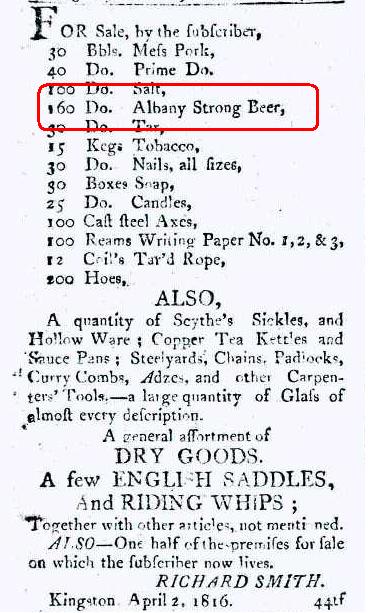 We have not found more Albany ale information for a while but this is your moment of zen. Just consider what it means. There is no Erie Canal. There are rapids on the St. Lawrence all the way to Montreal. There are about 4,000 people in this town. The War of 1812 ended one shipping season before… unless it was brought by sleigh. Oh, and “Do.” does not mean dozen. It means “ditto” so those are barrels. Amazing. From the Kingston Gazette on April 27th 1816.
We have not found more Albany ale information for a while but this is your moment of zen. Just consider what it means. There is no Erie Canal. There are rapids on the St. Lawrence all the way to Montreal. There are about 4,000 people in this town. The War of 1812 ended one shipping season before… unless it was brought by sleigh. Oh, and “Do.” does not mean dozen. It means “ditto” so those are barrels. Amazing. From the Kingston Gazette on April 27th 1816.

[Original comment…]
Ron Pattinson – October 18, 2011 3:54 PM
http://barclayperkins.blogspot.com/
Intriguing that it says Albany Strong Beer not Ale. Quite a lot of beer, too.
Alan – March 30, 2012 8:21 AM
I never got back to you, Ron. The quantity is because Kingston is the last safe point, a wholesale depot for the colony that extends to the west through the Great Lakes at this point in time.
Steve Gates – March 30, 2012 7:27 PM
Would it be your premise that Albany Ale was distributed to places like Belleville, Bath and Hallowell from Kingston? That might explain the 160 bbls that Smith had on hand, it’s alot of beer for retail in a fledgling community even with a military presence. How do you suspect that beer from Albany made it to Kingston? Overland to Sackett’s Harbour and shipped across perhaps? What do you think Alan?
Steve Gates – March 31, 2012 12:16 AM
Alan, by the way, your sleuthing of that Albany Ale reference in Mr. Smith’s store was very impressive. This from a guy who has spent more than his fair share on the microfilms in this fair town. I would have loved to have found it for my book and researched the reference. I find all this Albany material extremely intriguing and wonder if it was ever shipped to communities westward.
Alan – March 31, 2012 12:18 AM
I think it is further than that. I think until York gets a foothold and security, Kingston is the depot for the west of Upper Canada. In 1816, they have to bring in volume that is needed to service the colony but exceeds local Kingston brewing capacity. I bet they are bringing it up in those large row boats or batteaux from Montreal via Lake Champlain.
Alan – March 31, 2012 12:22 AM
But your book is exactly on point – the brewing. I add an interest in the trade routes and the cultural reasons for those. I get that from my own past work in import / export. I assume things about trade. But I miss stuff about production. Two different angles. I am now focusing on finding early records on the shipments of malt. Sales of malt imply brewing even if there is no brewing records. Albany is most frustrating as they were very self-sufficient. Local grain, hops, malting, cooperage? It’s all likely being done within family businesses making trade or tax records scarce.
Steve Gates – April 2, 2012 12:38 AM
Oftentimes I forget that York was indeed subaltern to Kingston in those early days, I am now focusing my attention to the Quinte District in terms of researching the early days of malting and brewing, if you come on to interesting references to Belleville, Picton and Trenton please pass them on to me. I’ll let you know if I find an Albany Ale reference when I’m researching in other communities. Cheers.
Alan – April 2, 2012 8:14 AM
Perfect!